
From Liquid to Sphere: The Art and Science of Spherification
Spherification is arguably the most iconic and visually stunning technique to emerge from the world of molecular gastronomy. It is a process that transforms a liquid into a sphere that bursts in the mouth, releasing a concentrated burst of flavor. While the result may seem like a magical feat of culinary alchemy, the science behind it is an elegant and accessible chemical reaction between two key ingredients: sodium alginate and a calcium solution.
The Core Ingredients: Sodium Alginate and Calcium
The heart of spherification lies in the interaction between a hydrocolloid and a mineral.
- Sodium Alginate: This is a natural polysaccharide extracted from brown algae. When dispersed and hydrated in a liquid, it forms a viscous solution.
- Calcium Ions: Calcium is a mineral essential for this reaction. Common sources of calcium in spherification are calcium lactate, calcium chloride, or calcium gluconate.
The fundamental principle is that when a solution containing …
From Liquid to Sphere: The Art and Science of Spherification READ MORE
